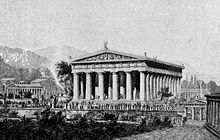
In Greek mythology, Agamemnon was a king of Mycenae who commanded the Achaeans during the Trojan War. He was the son of King Atreus and Queen Aerope, the brother of Menelaus, the husband of Clytemnestra, and the father of Iphigenia, Iphianassa, Electra, Laodike, Orestes and Chrysothemis. Legends make him the king of Mycenae or Argos, thought to be different names for the same area. Agamemnon was killed upon his return from Troy by Clytemnestra, or in an older version of the story, by Clytemnestra's lover Aegisthus.

In Greek mythology, Atreus was a king of Mycenae in the Peloponnese, the son of Pelops and Hippodamia, and the father of Agamemnon and Menelaus. Collectively, his descendants are known as Atreidai or Atreidae.

In Greek mythology, Thyestes was a king of Olympia. Thyestes and his brother, Atreus, were exiled by their father for having murdered their half-brother, Chrysippus, in their desire for the throne of Olympia. They took refuge in Mycenae, where they ascended the throne upon the absence of King Eurystheus, who was fighting the Heracleidae. Eurystheus had meant for their lordship to be temporary; it became permanent because of his death in conflict.

In Greek mythology, Pelops was king of Pisa in the Peloponnesus region. He was the son of Tantalus and the father of Atreus.
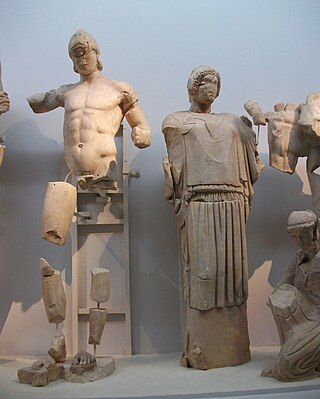
Hippodamia was a Greek mythological figure. She was the queen of Pisa and the wife of Pelops, appearing with Pelops at a potential cult site in Ancient Olympia.
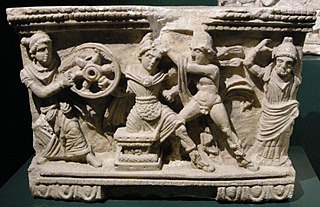
In Greek mythology, Myrtilus was a divine hero and son of Hermes. His mother is said variously to be the Amazon Myrto; Phaethusa, daughter of Danaus; or a nymph or mortal woman named Clytie, Clymene or Cleobule (Theobule). Myrtilus was the charioteer of King Oenomaus of Pisa in Elis, on the northwest coast of the Peloponnesus.
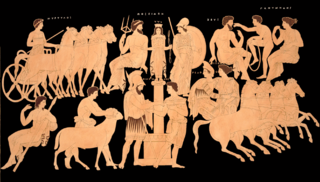
In Greek mythology, King Oenomaus of Pisa, was the father of Hippodamia and the son of Ares. His name Oinomaos denotes a wine man.
Panhellenic Games is the collective term for four separate religious festivals held in ancient Greece that became especially well known for the athletic competitions they included. The four festivals were: the Olympic Games, which were held at Olympia in honor of Zeus; the Pythian Games, which took place in Delphi and honored Apollo; the Nemean Games, occurring at Nemea and also honoring Zeus; and, finally, the Isthmian Games set in Isthmia and held in honor of Poseidon. The places at which these games were held were considered to be "the four great panhellenic sanctuaries." Each of these Games took place in turn every four years, starting with the Olympics. Along with the fame and notoriety of winning the ancient Games, the athletes earned different crowns of leaves from the different Games. From the Olympics, the victor won an olive wreath, from the Pythian Games a laurel wreath, from the Nemean Games a crown of wild celery leaves, and from the Isthmian Games a crown of pine.

692 Hippodamia, provisional designation 1901 HD, is a stony asteroid from the outer region of the asteroid belt, about 45 kilometers in diameter. It was discovered on 5 November 1901, by the German astronomers Max Wolf and August Kopff at Heidelberg Observatory in southern Germany. Nine years later, the body was rediscovered by August Kopff at its apparition in 1910.

The Temple of Zeus at Olympia was an ancient Greek temple in Olympia, Greece, dedicated to the god Zeus. The temple, built in the second quarter of the fifth century BC, was the very model of the fully developed classical Greek temple of the Doric order.
In Greek mythology, the Taraxippus was a presence, variously identified as a ghost or dangerous site, blamed for frightening horses at hippodromes throughout Greece. Some taraxippoi were associated with the Greek hero cults or with Poseidon in his aspect as a god of horses who brought about the death of Hippolytus. Pausanias, the ancient source offering the greatest number of explanations, regards it as an epithet rather than a single entity.
Ancestral sin, generational sin, or ancestral fault, is the doctrine that teaches that individuals inherit the judgement for the sin of their ancestors. It exists primarily as a concept in Mediterranean religions ; generational sin is referenced in the Bible in Exodus 20:5.

The Archaeological Museum of Olympia is one of the principal museums of Greece, located in Olympia. It is overseen by the Ministry of Culture and Sports, and, as of 2009, is directed by Georgia Xatzi. When the original building was completed and opened in 1888, it was the first museum in Greece outside of Athens.
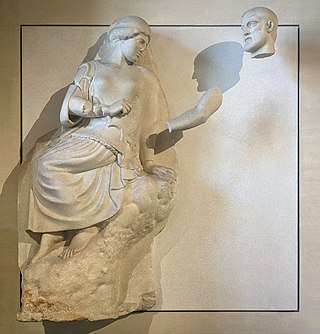
The Olympia Master is the name given to the anonymous sculptor responsible for the external sculpture of the Temple of Zeus, Olympia. From what Pausanias tells us of the dates of the Temple, the Master and his workshop were active between 470 and 457 BC. The two pediments and the series of metopes ascribed to him are the paradigmatic expression of the Early Classical or Severe style of 5th century Greek sculpture.

The ancient Olympic Games, or the ancient Olympics, were a series of athletic competitions among representatives of city-states and one of the Panhellenic Games of ancient Greece. They were held at the Panhellenic religious sanctuary of Olympia, in honor of Zeus, and the Greeks gave them a mythological origin. The originating Olympic Games are traditionally dated to 776 BC. The games were held every four years, or Olympiad, which became a unit of time in historical chronologies. These Olympiads were referred to based on the winner of their stadion sprint, e.g., "the third year of the eighteenth Olympiad when Ladas of Argos won the stadion". They continued to be celebrated when Greece came under Roman rule in the 2nd century BC. Their last recorded celebration was in AD 393, under the emperor Theodosius I, but archaeological evidence indicates that some games were still held after this date. The games likely came to an end under Theodosius II, possibly in connection with a fire that burned down the temple of the Olympian Zeus during his reign.
In Greek mythology, Sithon was a king of the Odomanti or Hadomanti in Thrace, and presumably the eponym of the peninsula Sithonia and the tribe Sithones.

The Greek lyric poet Pindar composed odes to celebrate victories at all four Panhellenic Games. Of his fourteen Olympian Odes, glorifying victors at the Ancient Olympic Games, the First was positioned at the beginning of the collection by Aristophanes of Byzantium since it included praise for the games as well as of Pelops, who first competed at Elis. It was the most quoted in antiquity and was hailed as the "best of all the odes" by Lucian. Pindar composed the epinikion in honour of his then patron Hieron I, tyrant of Syracuse, whose horse Pherenikos and its jockey were victorious in the single horse race in 476 BC.
In Greek mythology, Aristomachus may refer to several figures including:

Athletics were an important part of the cultural life of Ancient Greeks. Depictions of boxing and bull-leaping can be found back to the Bronze Age. Buildings were created for the sole use of athletics including stadia, palaestrae, and gymnasiums. Starting in the Archaic period, Panhellenic Games, including the Olympic Games, begin taking place each year. These games gave people from all over Greece the chance to gain fame for their athletic prowess. Athletics in Greece became one of the most commonly depicted scenes of everyday life in their art.
In Greek mythology, Pallene is a Macedonian or Thracian princess, the daughter of King Sithon who ruled over Odomantice, an ancient region right where Macedonia meets Thrace. Pallene saw many of her potential suitors die at the hands of her father, who decreed that only whoever beat him in fight would wed Pallene and rule the kingdom, until one day the life of the suitor she was in love with was at stake, forcing her to take the situation in her own hands. In other stories, she consorts with Dionysus, the god of festivity and wine.

